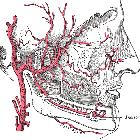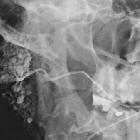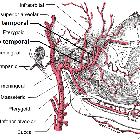maxillary artery



The (internal) maxillary artery is the larger of the two terminal branches of the external carotid artery.
Origin and course
The maxillary artery's origin is behind the neck of the mandible, at first, it is embedded in the substance of the parotid gland. From there it passes anterior between the ramus of the mandible and the sphenomandibular ligament, and then runs, either superficial or deep to the lateral pterygoid muscle, to the pterygopalatine fossa. It supplies the deep structures of the face.
The maxillary artery is divided into three portions by its relation to the lateral pterygoid muscle:
- first (mandibular) part: posterior to lateral pterygoid muscle (five branches)
- second (pterygoid or muscular) part: within lateral pterygoid muscle (five branches)
- third (pterygopalatine) part: anterior to lateral pterygoid muscle (six branches including terminal branch)
Branches
First (mandibular) part
Five branches, each of which enters a bony foramen:
- deep auricular artery (enters squamotympanic fissure)
- anterior tympanic artery (enters squamotympanic fissure)
- middle meningeal artery (enters foramen spinosum)
- accessory meningeal artery (enters foramen ovale)
- inferior alveolar artery (enters mandibular foramen)
- artery to mylohyoid
Second (pterygoid or muscular) part
Five branches although pterygoid branches are irregular in their number and origin:
- anterior, middle and posterior deep temporal branches
- pterygoid branches
- masseteric artery
- buccinator artery
Third (pterygopalatine) part
Six branches including the terminal branch:
- posterior superior alveolar artery
- infraorbital artery (enters inferior orbital fissure)
- artery of the pterygoid canal
- pharyngeal artery (enters palatovaginal canal)
- greater (descending) palatine artery (enters greater palatine foramen)
- sphenopalatine artery - terminal branch (enters sphenopalatine foramen)
A long mnemonic to remember these branches is:
- DAM I AM Piss Drunk But Stupid Drunk I Prefer, Must Phone Alcoholics Anonymous
Siehe auch:
- Arteria carotis externa
- Glandula parotidea
- Arteria buccalis
- Arteria infraorbitalis
- deep temporal branches
- Äste der Arteria maxillaris
- Arteria masseterica
und weiter:

 Assoziationen und Differentialdiagnosen zu Arteria maxillaris:
Assoziationen und Differentialdiagnosen zu Arteria maxillaris:



